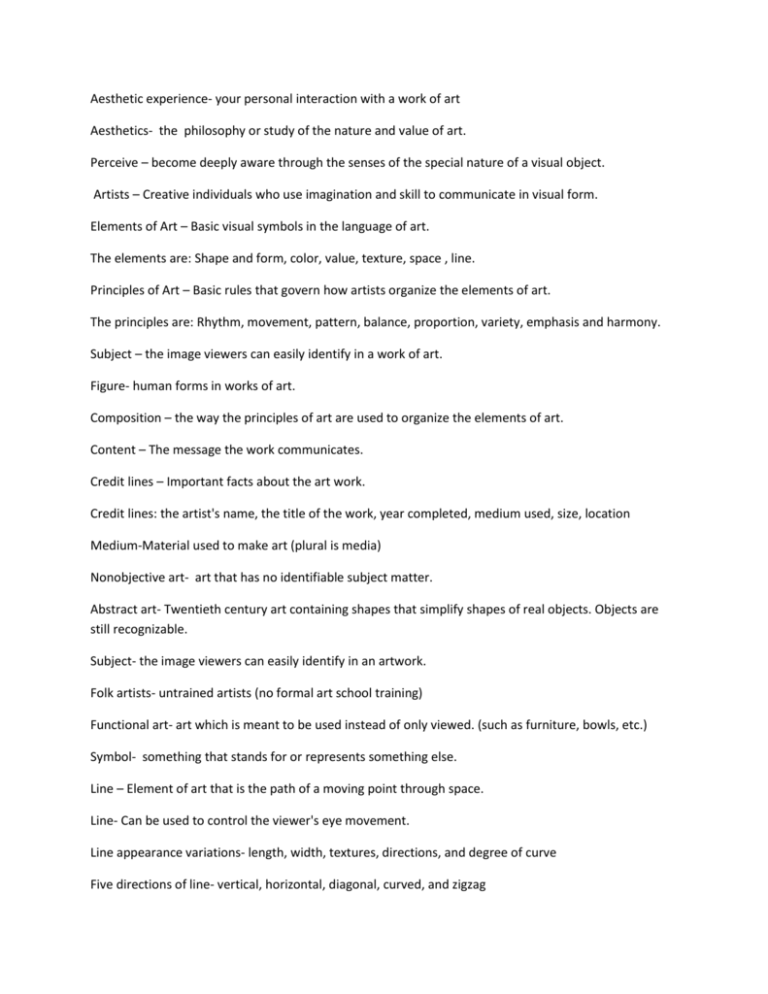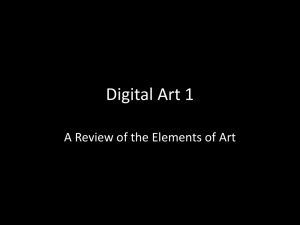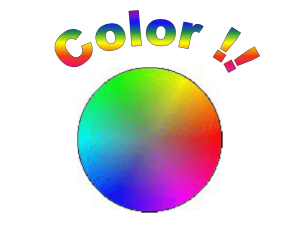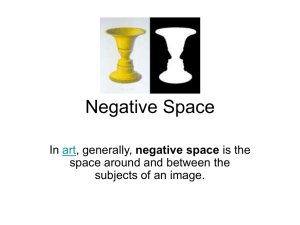Aesthetic experience- your personal interaction with a work of art
advertisement

Aesthetic experience- your personal interaction with a work of art Aesthetics- the philosophy or study of the nature and value of art. Perceive – become deeply aware through the senses of the special nature of a visual object. Artists – Creative individuals who use imagination and skill to communicate in visual form. Elements of Art – Basic visual symbols in the language of art. The elements are: Shape and form, color, value, texture, space , line. Principles of Art – Basic rules that govern how artists organize the elements of art. The principles are: Rhythm, movement, pattern, balance, proportion, variety, emphasis and harmony. Subject – the image viewers can easily identify in a work of art. Figure- human forms in works of art. Composition – the way the principles of art are used to organize the elements of art. Content – The message the work communicates. Credit lines – Important facts about the art work. Credit lines: the artist's name, the title of the work, year completed, medium used, size, location Medium-Material used to make art (plural is media) Nonobjective art- art that has no identifiable subject matter. Abstract art- Twentieth century art containing shapes that simplify shapes of real objects. Objects are still recognizable. Subject- the image viewers can easily identify in an artwork. Folk artists- untrained artists (no formal art school training) Functional art- art which is meant to be used instead of only viewed. (such as furniture, bowls, etc.) Symbol- something that stands for or represents something else. Line – Element of art that is the path of a moving point through space. Line- Can be used to control the viewer's eye movement. Line appearance variations- length, width, textures, directions, and degree of curve Five directions of line- vertical, horizontal, diagonal, curved, and zigzag Active - expressing movement. Diagonal and zigzag lines are active. Opposite of static. Sketch- quick, rough ,drawing without much detail that can be used as a plan or reference for later work. Static- Inactive. Horizontal and vertical lines are static. Dimension – The amount of space an object takes up in one direction. Value – The element of art that describes the lightness or darkness of an object. Crosshatching – The technique of using crossed lines for shading. Parallel lines- lines that move in the same direction Hatched lines-technique of shading with finely spaced parallel lines Stippling- technique of shading using dots. Calligraphy – An Asian method of beautiful handwriting. Shape – A two-dimensional area that is defined in some way. Geometric Shapes – Precise shapes that can be described using mathematical formulas. Free-Form shapes/forms – Irregular and uneven shapes/forms. Organic shapes/forms- shapes formed by nature (fruit, trees, etc.) Forms – Objects having three dimensions: depth, height and width). Space – element of art: the emptiness or area between, around, above, below, or within objects. Negative space- empty spaces surrounding shapes and forms. Negative spaces are also called ground. Positive space- Shapes or forms in two and three dimensional art work . Sculpture- a three-dimensional work of art Free-standing or sculpture in the round- a sculpture which is surrounded on all sides by space. Point of View – The angle from which your eyes see the object. Chiaroscuro- Italian word meaning "the arrangement of light and shadow". Also called "shading" Linear Perspective- creates the illusion of depth and volume on a 2-dimensional surface. Linear Perspective- Originated in Italy during the Renaissance period. Foreshortening- To shorten an object to make it looks as if it extends backward into space Horizon line-Horizontal line parallel to the bottom edge of the paper. Indicates eye level Vanishing points- used in linear perspective drawing. Points on the horizon line where receding parallel lines seem to meet. Color - an element of art derived from reflected light. The Three properties of color are hue, value and intensity. Hue - is the name of a color in the color spectrum Intensity- the brightness or dullness of a color Arbitrary color - color chosen by an artist to express his or her feelings. The opposite of optical color. Optical color- Color perceived by the viewer due to light (how it actually looks- the "real" color). Complementary colors- colors opposite each other on the color wheel Split- complementary colors- one color and the colors on each side its complement on the color wheel. Color wheel- the spectrum bent into a circle. Useful tool for organizing colors Primary colors- red, blue, yellow Transparent- quality of a material that allows light to pass through. The opposite of opaque. Opaque - quality of a material that does not allow light to pass through. Secondary colors- made by mixing two primary colors Intermediate (tertiary) colors- made by mixing a primary with a secondary color that are closest together on the color wheel. Neutral colors- black, white, grey. Value-element of art that describes dark or light Intensity- the brightness or dullness of a hue (color) Dyes- Pigments that dissolve in liquid. Dye sinks into a material and permanently stains it. Paint- Pigments mixed with oil or water. Pigment particles in paint stick to the surface of the material to which it is applied. Monochromatic color scheme- one color and the tints/shades of that color Analogous colors- at least four colors that sit side by side on the color wheel and have a common color Warm colors- red , orange and yellow Cool colors- blue, green, violet (purple) Pigments- finely ground, colored powders that form paint with mixed with a binder. Binder-a material that holds together the grains of pigment Solvent- liquid that controls the thickness or thinness of the paint. Tint- light value of a color made by mixing the color with white. Opposite of shade. Shade- a dark value of a color made by adding black to it. Opposite of tint. Texture- the element of art that refers to how things feel, or look as if they might feel, if touched. Visual texture- the illusion of a three-dimensional surface, perceived through eyes. Tactile texture-the texture that you feel, perceived by touch Simulated texture- visual texture that imitatee real textures (like "fake" stone) Trompe l'oeil- French for "deceive the eye". Trompe l'loeil -Style of painting in which painter s try to give the viewer the illusion of seeing a 3-D object. Matte surfaces- reflect soft, dull light Shiny surfaces reflects lots of bright light Highlight- area of bright light reflected on a surface Collage- created by pasting cut or torn materials such as paper, photographs, and fabric to a surface. Frottage (Rubbing) - a technique for transferring textural quality of a surface by placing paper over the surface and rubbing the top of the paper with crayon Grattage- wet paint is scratched with a variety of tools such as forks, sticks, and combs to create texture Decalcomania - paint is forced into random textured patterns by pulling apart canvases or papers between which blobs of paint have been squeezed. Rhythm- a principle of art that indicates movement by the repetition of elements or objects Pattern- a principal of art that is concerned with decorative surface design Motif- the unit that is repeated in a two-dimensional pattern Module- the unit that is repeated in a three-dimensional pattern Visual movement- the principles of art used to create the look and feeling of action and to guide the viewer's eyes throughout the work of art. Relief (bas) sculpture- type of sculpture in which forms project from a flat background. Opposite of freestanding (example: objects that project on a coin). Kinetic - sculpture that moves in space. Mobiles- kinetic sculptures made of shapes that hang in space and actually move due to air currents. Visual Balance- the principles of art concerned with equalizing visual forces, or elements, in a work of art. Central axis- a dividing line that works like the point of balance on a scale. Symmetry- a type of formal balance in which two halves of a composition are identical, mirror images of each other. Asymmetrical- informal balance involves a balance of unlike objects. Radial balance- type of balance in which elements of a design come (radiate) from a central point Golden Mean (Divine Proportion) - ratio (a mathematical comparison of sizes) developed by the Greek mathematician, Euclid, that many artists used to organize the sizes of their paintings. The ratio is 1:1.6 and also reflects the average adult male figure. Scale- the size of something as measured against a standard reference Hierarchal proportion-when figures are arranged in a work of art so that scale (size) indicates importance. Exaggeration and Distortion- deviations from the expected, normal proportions of figures or objects. Expressive quality- those qualities that communicate ideas and feelings. Variety is the principle of art concerned with difference or contrast. Emphasis is the principal of art that makes one part of a work dominant over the other parts. Focal point- the first part of a work to attract the attention of the viewer. Harmony- the Principle of art that creates unity by stressing the similarities of separate, but related parts. Unity- a Principle of art, a quality of wholeness or ones that is achieved through the effective use of the elements and principles of art. Background- the part of the picture plane that seems to be farthest from the viewer. Middle ground- area in a picture that is between the foreground and the background. Foreground- the part of a picture that appears closes to the viewer, usually at the bottom of the picture Portrait- Image of a person, especially the face and upper body. Profile- side view of a face Landscape- painting or drawing in which natural land scenery, such as trees or lakes, is the main feature. Grid- pattern of horizontal and vertical lines (like a checkerboard) Color triad - three colors equal distance from each other on the color wheel Three-Dimensional- an object that has the dimensions of height, width, and depth. Two-dimensional- an object that has the dimensions of height, and width Picture plane-The surface of a drawing or painting Implied line- A series of points that the viewer's eyes automatically connect. Implied lines are suggested, not real. Composition- the way the principles of art are used to organize the elements of art Outline-A line that shows or creates the outer edges of a shape Gesture drawing- Line drawing done quickly to capture movement of the subject's body. Gesture- An expressive movement Design- Plan, organization, or arrangement of elements in a work of art Grid- pattern of intersecting vertical and horizontal lines.







